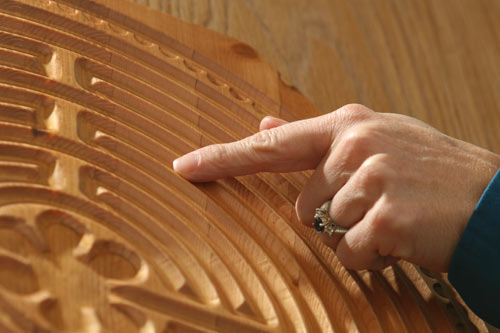
Nina Johnson traces her wooden finger labyrinth, based on the walking labyrinth in Chartres Cathedral, France.
Reprinted from Bridges Magazine, Issue 10, Fall 2013
April 2014 Update: On Sunday, May 4 at 2pm, come celebrate Jane’s Walk and World Labyrinth Day at the River’s Trail Labyrinth in Kamloops. Jane’s Walk is a worldwide event celebrating the legacy of Jane Jacobs, who imagined walkable neighbourhoods and cities. Jane’s Walks are free, locally organized walking tours in which people get together to explore, discuss, and celebrate their neighbourhoods. Nina Johnson, lecturer in the English and Modern Languages department at TRU and a Veriditas Labyrinth Facilitator, will lead a walk at the River’s Trail Labyrinth in Kamloops. World Labyrinth Day is May 3, 2014.
By Anita Rathje
Nina Johnson’s creative writing students often complain of writer’s block. From the distractions of mobile devices to the pressures of deadlines and grade point averages, mental static can get in the way when students try to put ideas into words. In a new research project, Johnson hopes to help them past the block with a unique mindfulness exercise: the finger labyrinth.
“When we’re blocked, it begins with anxiety,” says Johnson, a lecturer in the English and Modern Languages department and a Labyrinth Facilitator. “The labyrinth asks you to slow down and experience the moment, which then opens up opportunities to reflect in a very deep way and make connections.”

Nina Johnson is conducting research into whether finger labyrinths can help writers overcome writer’s block through contemplative practice.
Unlike a maze, which has dead ends and visual obstructions to make you lose your way and induce excitement or panic, a labyrinth has a single, non-linear path to its centre and out again, providing a sense of security even though you may not know how close you are to the end as the path twists and turns. In the tradition of other contemplative practices like meditation, yoga, or tai chi, walking a labyrinth cultivates relaxation, lessens anxiety and improves focus. Research has shown that such practices create both physical calm and mental alertness, which Johnson believes enhance creative inspiration.
Her research project, Labyrinths and Student Learning: the Effects of Contemplative Practices on Anxiety, Concentration, and Creativity, investigates whether students can not only get past their writer’s block, but find greater creativity.
“A mindfulness practice like the labyrinth enables you to enter a relaxed, receptive state where metaphoric and associative thinking can flourish,” says Johnson.
For this project, her participating ENGL 2060 students traced a finger labyrinth prior to writing a journaling exercise each day, and completed a survey on their anxiety and creativity levels at two-week intervals. Johnson looks forward to reviewing the results once the course is finished. She has also proposed installing a full-sized walking labyrinth on campus.
“There are so many benefits to walking a labyrinth,” she says. “They’re being used institutionally in hospitals, prisons, art centres and university campuses, for treating stress, ADHD, trauma and autism. There’s a huge application for wellness and quality of life.” She hopes her research will show it is also a valuable practice to support student learning. “It’s an experiential, transformational way of learning.”
In her own discovery of the labyrinth, Johnson has found the changing directions of the path very much a metaphor for life, and at each turn, she says, come moments of creative insight.
After a successful project last fall, Johnson will continue her research with creative writing students in Fall 2014, using the labyrinth and journal in two classes.

